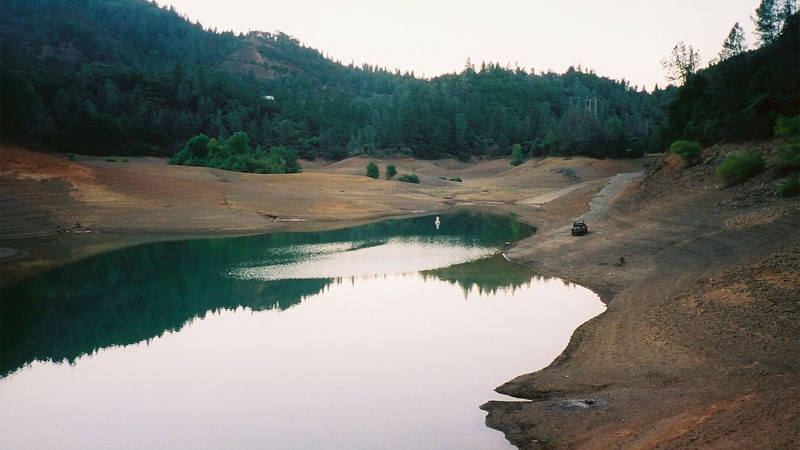Sacramento Region Big Day of Giving is May 1, 2025. Learn More.
As California’s water levels continued to fall, residents increased their water consumption.

Low rainfall from 2019 to 2022 left Shasta Lake—the state’s largest reservoir—filled to just 39 percent of its capacity. Bobjgalindo Creative Commons
A new meteorological report shows that California has come up short by a full year’s worth of rainfall in just the last three years—even as, according to data from the State Water Resources Control Board, Californians defy Gov. Gavin Newsom’s plea to cut back on water consumption. In April of 2022, state water use jumped 18 percent from the previous year, according to the data.
In fact, California—mostly Southern California—is consuming more water than before the governor’s plea, while the amount of rain that fell in Northern California, between July 1, 2019, and June 30, 2022, measured only about two-thirds of what would be expected in an average three-year time period, according to the report by Half Moon Bay-based Golden Gate Weather Services.
“It’s like if you worked three years but only got paid for two,” Jan Null, a meteorologist with Golden Gate Weather Services, told Bay Area News Group. “You are going to be hurting.”
Over the past rainfall year (July 1, 2021, to June 30, 2022), the rainfall shortage appears most acute in Northern California, according to the data compiled by Golden Gate Weather Services. San Jose, in that time period, recorded only 54 percent of normal levels—with “normal” defined as an average of the years 1991 through 2020. Mount Shasta and the Montague/Siskiyou region fared the worst, with 46 percent and 40 percent of normal levels respectively.
Northern California Reservoirs Are Drying Up
Northern California is the state’s most important region for rainfall, because that’s where many of the state’s largest reservoirs are located. But according to data from the California Department of Water Resources, most of those reservoirs remain seriously depleted. Per data last updated on June 28, 2022, Shasta Lake in Shasta County—the state’s largest reservoir, holding up to 4.5 million acre-feet of water (enough to meet the yearly needs of 23 million people)—was filled to just 39 percent of its capacity and 50 percent of its average volume.
(One acre-foot is approximately equal to the amount of water it takes to cover a football field one-foot deep—about 326,000 gallons.)
Butte County’s Lake Oroville, the second largest California reservoir at 3.5 million acre-feet, was at 50 percent capacity, and 56 percent of average, while Trinity Lake—third ranked at just under 2.5 million acre-feet—held only 29 percent of its capacity and 43 percent of average.
On June 28, according to the U.S. Drought Monitor, 59.81 percent of California suffered under “extreme” drought conditions with 97.48 percent under “severe” drought. The U.S. Drought Monitor is a project of the federal government, operated through the University of Nebraska.
Second ‘Missing Year’ of Rainfall in the Last Decade
The shortfall equivalent to a year’s worth of rainfall from 2019 to 2022 was the second missing year of rain in the past decade. Rainfall measured over the two-year period from July 1, 2012, to June 30, 2014, also came up a year short, according to a study published by the Journal of Geophysical Research – Atmospheres and reported by the site Weather Underground.
According to the research in the study cited by Weather Underground, an average year in California at that point produced 20 inches of rain. But that was the same amount “missing,” or below average, in the 2012 to 2014 period.
The Journal of Geophysical Research study said that the rain shortfall in that time period was caused by the absence of “atmospheric rivers,” the long streams of water-filled air that flow in the sky from tropical regions, where they pick up large amounts of moisture, to land where they dump that moisture in the form of heavy rainfall.
Less Water, But More Water Use in California
Even as the ongoing drought gets worse with no signs of letting up, Californians—mostly in Southern California—apparently refuse to cut back on the amount of water they use. In July of 2021, Newsom called on Californians to voluntarily cut back on the amount of water they consume by 15 percent.
Instead, water use in April 2022 was up by 18 percent from the same month two years previously, according to Water Resources Control Board data. Of 300 water suppliers from which the board collected data, only 18, or 6 percent, met the 15 percent reduction goal.
The worst offender was the City of El Segundo in Los Angeles County, which jacked up its water consumption by an astonishing 42.9 percent. Fortunately, El Segundo was somewhat of an outlier, but not too far out. The Lee Lake Water District, located in Corona, came in second on the water-hog list with an increase of 21.2 percent.
However, the Northern California cities of Redding and Eureka cut back on water use by 7.8 and 7.9 percent respectively. The San Jose Water Company saw a 9.2 percent reduction, while the Sonoma County City of Healdsburg set an example for the state, reducing water consumption by 38.3 percent between 2020 and 2022.